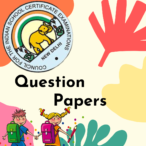GEOGRAPHY
H.C.G.
Paper – 2
PART I
![]() Q. 1 Study the extract of the Survey of India Map sheet No. 45D/10 and answer the following questions:
Q. 1 Study the extract of the Survey of India Map sheet No. 45D/10 and answer the following questions:
(a) (i) Give a six figure grid reference for the spot height .324 in northern part of the map extract.
(ii) Give a four figure grid reference for open scrub south of Dhad Talao.
(b) (i) What is the meaning of the term ‘Contour interval’?
(ii) What is the contour interval of the sheet provided to you?
(c) What is the area in kilometre square of the region between 06 and 09 Eastings and 22 and 27 Northings?
(d) What is the significance of the following colours used on the survey map?
(i) Yellow colour.
(ii) Green colour.
(e) What is the compass direction of?
(i) Idarla (0825) from Bhamra (0420).
(ii) Dhana (0623) from Amarapura (0124).
(f) (i) Name the settlement pattern seen in the grid square 0819.
(ii) Name the drainage pattern seen in the grid square 0827.
(g) (i) Name two man made features seen in the grid square 0723.
(ii) Name two natural features seen in the grid square 0218.
(h) (i) What is the black horizontal line drawn between 18 and 19 Northings?
(ii) Name the most important settlement of the region shown on the map extract.
(i) Draw the conventional symbol for each of the following:
(i) Lined perennial well.
(ii) Seasonal tank.
(j) (i) Give one evidence to prove that the regions shown on the map extract receive scanty rainfall.
(ii) What is .5r in the grid square 0321?
![]() Q. 2 On the outline map of India provided:
Q. 2 On the outline map of India provided:
(a) Mark and name Nilgiris.
(b) Mark and name Kochi.
(c) Mark and name the Karakoram Pass.
(d) Mark and name 82½oE Longitude.
(e) Shade and name the Coromandel Coastal Plain.
(f) Mark and name the River Brahmaputra.
(g) Mark and name the Gulf of Kutch.
(h) Mark and name the Satpura.
(i) Mark using arrows, the direction of the South West Monsoon wind during summer over the Arabian Sea and label it.
(j) Shade and label a sparsely populated region in India.
Index No.……………………………………………. UID……………………………..
(This map, if used, must be fastened with all other answers)
Map of India for Q. 2
PART II
![]() Q. 3 (a) (i) Name one state in the north western part of India that receives rainfall during winter.
Q. 3 (a) (i) Name one state in the north western part of India that receives rainfall during winter.
(ii) What is the source of this rainfall?
(b) Give a reason for each of the following:
(i) Rainy season in India is after the summer season.
(ii) Tamil Nadu has more rainy months than Kerala, yet, Kerala receives more rainfall than Tamil Nadu.
(c) (i) What do you understand by the term “Burst of Monsoon”? Name the state that experiences the “Burst of Monsoon”.
(ii) Even though India gets abundant rainfall during the rainy season, yet, some places experience drought. Explain giving suitable examples.
(iii) Why is Shimla colder than Delhi during summer?
(d) Study the climatic data given below and answer the questions that follow:
| Months | Jan | Feb | Mar | Apr | May | Jun | Jul | Aug | Sep | Oct | Nov | Dec |
| Temp. in °C | 8.4 | 11.5 | 21.6 | 28.3 | 35.1 | 38.5 41.0 | 38.0 | 30.8 | 29.2 | 15.6 | 10.2 | |
| Rainfall in cms. | 1.5 | 0.9 | 0.5 | – | – | 12.5 | 17.8 | 18.5 | 12.5 | 12.5 | 6.2 | 2.1 |
(i) Calculate the annual range of temperature.
(ii) State whether the station is located in the coastal area or in the continental interior.
(iii) Name the wind that brings most of the rainfall to this area.
![]() Q. 4 (a) (i) Name the parent rock that contributes to the formation of red soil.
Q. 4 (a) (i) Name the parent rock that contributes to the formation of red soil.
(ii) How does this soil get its ‘red’ colour?
(b) Name the following:
(i) a soil that occurs insitu and is good for cotton crop.
(ii) soil that is formed due to high temperature and heavy rainfall.
(c) With reference to Alluvial Soil answer the following:
(i) What are the two types of Alluvial Soil?
(ii) Name an area where Alluvial soil is found.
(iii) Name two crops that grow well in this soil.
(d) (i) Define the term ‘Residual’ soil.
(ii) Name two crops that are grown on laterite soil.
(iii) Name two important agents of soil erosion.
![]() Q. 5 (a) State two ways by which forests help in protecting the environment.
Q. 5 (a) State two ways by which forests help in protecting the environment.
(b) With reference to Tropical Deciduous forests answer the following questions:
(i) Name two states where it is found.
(ii) Name two important trees found in this forest.
(c) Briefly explain the following:
(i) Why are Tropical Evergreen forests called “Evergreen”?
(ii) Why is afforestation essential in the cities that have Iron and Steel industries?
(iii) How do forests act as a source of income for the people.
(d) Give a reason for each of the following:
(i) The Tropical Deciduous forest is commercially the most important forest belt in India.
(ii) Tropical Evergreen forests occur on the windward side of Western Ghats.
(iii) It is very difficult to move through tidal forests.
![]() Q. 6 (a) Mention any two methods of recharging groundwater aquifers.
Q. 6 (a) Mention any two methods of recharging groundwater aquifers.
(b) (i) Name the most common means of irrigation used in India.
(ii) Give one reason for the popularity of this means of irrigation in our country.
(c) (i) Name two states of India where Canal irrigation is extensively used.
(ii) Name the types of canals used in India.
(iii) Mention one point of difference between the types of canals mentioned by you.
(d) (i) What geographical conditions make irrigation necessary in the country?
(ii) How has irrigation changed the cropping pattern in India?
(iii) Why is there a scarcity of surface water in our country?
![]() Q. 7 (a) (i) Why is iron ore called the backbone of our modern industry?
Q. 7 (a) (i) Why is iron ore called the backbone of our modern industry?
(ii) Mention two uses of iron ore.
(b) Mention one agricultural and one industrial problem solved by the Bhakra Nangal Dam.
(c) (i) Name the state that is the leading producer of Manganese.
(ii) Name the mineral oil field of India which is the largest producer of Petroleum.
(iii) Mention two advantages of using Geothermal energy over coal.
(d) (i) Mention one disadvantage of using natural gas as a source of power.
(ii) How is the residue from a Bio-gas plant put to use?
(iii)Why is the use of alternative sources of energy becoming essential in modern time?
![]() Q. 8 (a) Mention two points of difference between subsistence farming and commercial farming.
Q. 8 (a) Mention two points of difference between subsistence farming and commercial farming.
(b) Explain briefly the following terms:
(i) Ginning.
(ii) Ratooning.
(c) With reference to the wheat crop answer the following questions:
(i) Name the state which is the leading producer of this crop in India.
(ii) Mention the climatic condition found suitable for the cultivation of this crop.
(d) Give a geographical reason for each of the following:
(i) Cultivation of rice requires flat level land.
(ii) Pulses are important rotation crops.
(iii) Bajra and Jowar are grown as dry crops.
![]() Q. 9 (a) Give two reasons as to why Mumbai has developed into an important cotton textile centre.
Q. 9 (a) Give two reasons as to why Mumbai has developed into an important cotton textile centre.
(b) (i) What are Basic Industries?
(ii) Give one example of a Basic Industry in India.
(c) (i) State two problems faced by the Silk Industry of India.
(ii) Mention the most important factor for location of Sugar industries.
(d) Briefly answer the following:
(i) From where does the Rourkela Steel plant obtain its supply of coal?
(ii) From where does the Tata Iron and Steel plant obtain its supply of iron ore?
(iii) Name two cities that are important for the production of Electronics.
![]() Q. 10 (a) With reference to Waterways answer the following questions:
Q. 10 (a) With reference to Waterways answer the following questions:
(i) Mention two advantages of inland water transport.
(ii) Why is inland water transport not well developed in India?
(b) Even though all means of transport are well developed in India, yet, road transport remains the most popular means of transport. Justify this statement.
(c) Give a reason for each of the following:
(i)Roadways is not well developed in North East India.
(ii)Railways are under the public sector.
(iii)A good network of transport is of great help for the development of the economy.
(d) (i) Give two disadvantages of Airways.
(ii) Why is there an increase of airway traffic in recent years?
![]() Q. 11 (a) (i) What do you mean by segregation of waste?
Q. 11 (a) (i) What do you mean by segregation of waste?
(ii) Why is segregation of waste essential before its disposal?
(b) Why should sewage be treated before disposal?
(c) Briefly answer each of the following:
(i) What is the effect of Waste accumulation on terrestrial life?
(ii) What are the consequences of Water pollution?
(iii) What is the benefit of Composting?
(d) (i) How can recycling of Waste help in reducing waste? Explain with suitable examples.
(ii) Mention one initiative taken by the Government to manage waste.
(iii) How can you as an individual contribute towards waste management?



